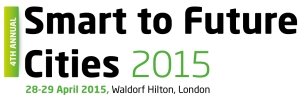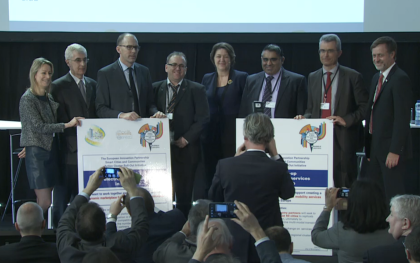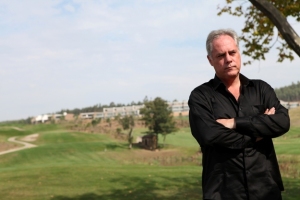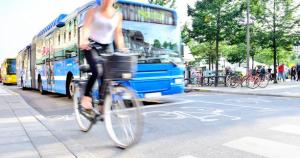
The first speakers have been announced for the 4th Annual Smart to Future Cities 2015, and the draft agenda is now available to download.
Event background
Taking place at the Waldorf Hilton in London, on 28-29 April 2015, the Smart to Future Cities conference has gone from strength to strength over recent years, charting the transition of the smart city concept from definition to implementation as IoT enables applications that benefit citizens and urban planners. In April 2014 we hosted over 250 industry experts, 80 of whom were from international city administrations.
The conference is renowned for being the right size for constructive discussion and networking where cities can talk directly to other cities; as our delegates said:
“The Smart Cities conference 2014 was an outstanding experience. Several of the conversations I had during the conference have translated into tangible projects with real outcomes” – Future Cities Lab
“There is the possibility to meet important and significant people at an event that is the right size. It is not a large expo, where you get lost in the crowd ” – Bilbao City Council
“Great line up of speakers and very insightful. I felt I was learning at the leading edge of Smart City thinking” – Milton Keynes Council
“One of the best SMART Cities event I’ve been to. A good mix of speakers and delegates.” – Happold Consulting
2015 sees the concept of Smart Cities continuing to evolve as the focus shifts to the citizen and their central place in the design of the smart city and the IoT applications and services that enable it. Services such as smart parking, mobility, energy, health, safety and security and many more are enabled by urban IoT as everything within the city becomes internet connected.
Agenda and speakers
Download the draft agenda here, to see what will be up for discussion. Our early-confirmed speakers include:
Ger Baron, Chief Technology Officer, City of Amsterdam
Cllr James Noakes, Mayoral lead for Energy and Smart City, Liverpool City Council
Geoff Snelson, Director of Strategy, Corporate Core, Milton Keynes
Petra Dalunde, Project manager and Communication Strategist at Stockholm Business Region Development, City of Stockholm
Dave Carter, Chair, European Connected Smart Cities Network – Centre for Urban Policy Studies (CUPS), Manchester, UK
Josu Santacruz, Smart Cities, Centro Informático Municipal de Bilbao (Cimubisa), Spain
Steve Turner, Head of City Policy, Manchester
Vojko Obersnel , Mayor of the City of Rijeka, Croatia
Erling Fossen, CEO – Oslo Metropolitan Area, Oslo – Norway
Else Kloppenborg, Special Adviser, Smart Cities, City of Copenhagen
Veera Mustonen, Project Leader, Smart Kalasatama, City of Helsinki
Michael McLaughlan, Programme Director, Glasgow Future Cities Demonstrator Programme
Richard Miller, Head of Sustainability, Technology Strategy Board
See-Kiong Ng, Programme Director, Institute for Infocomm Research – Singapore
Loveleen Garg, Assistant Vice President, Gujarat International Finance Tech City Co. Ltd
Ahmed Jebreel Fallatah, Telecom Project Manager, Telecoms, Royal Commission for Yanbu, Saudi Arabia
Andrew Collinge, Head of Intelligence, Greater London Authority
Shane Rooney, Executive Director, Smart Cities & Transport, GSMA
Chris Pennell, Lead Analyst, Public Sector, Ovum
















 The European Parliament has just published a report mapping Smart Cities in the European Union. This is an attempt to identify the number of ‘smart cities’ and their activities across Europe. As usual, this report is confusing, weighty and difficult to summarize or remove excerpts. But defines a smart city as “a city looking to solve public problems through technologies developed and implemented on the basis of multi-stakeholder partnerships”.
The European Parliament has just published a report mapping Smart Cities in the European Union. This is an attempt to identify the number of ‘smart cities’ and their activities across Europe. As usual, this report is confusing, weighty and difficult to summarize or remove excerpts. But defines a smart city as “a city looking to solve public problems through technologies developed and implemented on the basis of multi-stakeholder partnerships”.